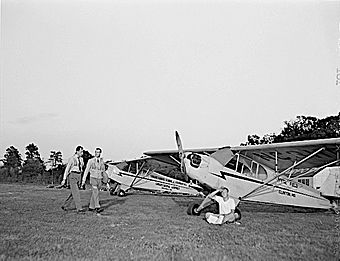Civilian Pilot Training Program facts for kids

The Civilian Pilot Training Program (CPTP) was a special program in the United States that taught people how to fly planes. It ran from 1938 to 1944. The main goal was to have more civilian pilots. But it also helped prepare the country for war.
Starting the Program
Before World War II began, countries in Europe like Italy and Nazi Germany started training many young people to be pilots. Even though they said these programs were for civilians, they were actually secret military flight schools.
In October 1938, General Henry H. "Hap" Arnold asked the leaders of three big aviation schools for help. He wanted them to start CPTP schools, even without money at first. They all agreed.
A new law in 1938 created the Civil Aeronautics Authority (CAA). This law allowed and paid for a test program, which became the CPTP. On December 27, 1938, President Franklin D. Roosevelt announced the program. He said it would help general aviation by training 20,000 college students each year.
Like the programs in Europe, the CPTP was officially for civilians. But everyone knew it could help with national defense. The program began in 1939. The government paid for a 72-hour ground school course. After that, students got 35 to 50 hours of flight instruction. These classes were held near eleven colleges and universities.
The program was a big success. It helped train many thousands of college students to fly. This greatly increased the number of pilots in the country. A report from 1970 said the program was first planned as a way to teach job skills. It aimed to help the aviation industry and create a group of skilled pilots for the military.
The CPTP started with 13 colleges and 330 students in 1939. By the summer of 1944, it had grown a lot. It included 1,132 schools and trained 435,165 people. This included many women. The program showed that new ideas were needed to help industries and national defense.
Growing the Program
The CPTP grew and added more classes to many colleges. In May 1939, the first nine schools were chosen. Nine more were added in August 1940, when the Battle of Britain was happening. By October 1941, just before the U.S. entered World War II, 15 more schools joined.
At its busiest, 1,132 schools and 1,460 flight schools were part of the CPTP. Many famous universities joined, like the University of Michigan and the Tuskegee Institute.
Including Tuskegee University and other historically Black colleges helped open doors for the first African-American military pilots. Because of World War II and public pressure, the U.S. Army Air Corps started hiring African-Americans as officers and pilots. Most of these pilots had trained through the CPTP.
Training civilian pilots also had another good effect. The United States needed more training planes. The government required CPTP flight schools to own one plane for every ten students.
This rule meant that only certain types of planes could be used. Many schools liked the Piper Cub because students sat one behind the other. Other plane makers like WACO and Meyers quickly built planes that fit the program's needs. This helped the aviation industry grow.
War Training Service
After the attack on Pearl Harbor and the U.S. joined World War II, the CPTP changed. It was renamed the War Training Service (WTS). From 1942 to 1944, it mainly helped find and prepare people who could become military pilots.
Students still went to colleges for classes. Private flight schools still taught them to fly. But now, all WTS graduates had to agree to join the military after finishing the program.
The CPTP/WTS program mostly ended in the summer of 1944. But by then, 435,165 people had learned to fly. This included many women and African-Americans.
Some famous people who trained with the CPTP include:
- Astronaut and Senator John Glenn
- Top Navy pilot Alexander Vraciu
- World War II pilot Major Richard Bong
- Pilot Bud Anderson
- Former Senator George McGovern
- WASP pilot Dora Dougherty
- Tuskegee Airman Major Robert W. Deiz
The CPTP did a great job of its main goal: "To Fill the Skies with Pilots."
Two of the biggest CPTP/WTS schools were Piedmont Aviation and Southern Airways. Piedmont's school was in Winston-Salem, North Carolina. Southern had schools in several states. Both companies trained over 60,000 pilots for the war. This included young men from Brazil and many pilots from England's Royal Air Force. After the war, these schools became successful airlines.
One of the few women who taught flying in the CPTP was Opal Kunz. She renewed her pilot's license and started teaching aviation students at Arkansas State College. Later, she moved to Rhode Island. During World War II, she became an instructor for Navy cadets and the CPTP. She taught over 400 young men how to fly for the Air Corps.
Opal Kunz loved teaching her "boys." She was happy to see them fly alone for the first time. She felt like a foster mother to them. After the war, many of her former students visited her with their families. She said, "I trained about 400 boys and it was easily the highlight of my career." She also mentioned that she trained combat pilots.
Several women who graduated from the CPTP, like Betty Tackaberry Blake, Florence Shutsy-Reynolds, and Betty Jane Williams, later became Women Airforce Service Pilots (WASP).
Images for kids
See also
 In Spanish: Programa de entrenamiento para pilotos civiles para niños
In Spanish: Programa de entrenamiento para pilotos civiles para niños


